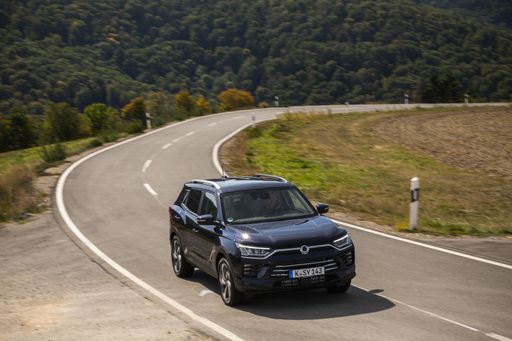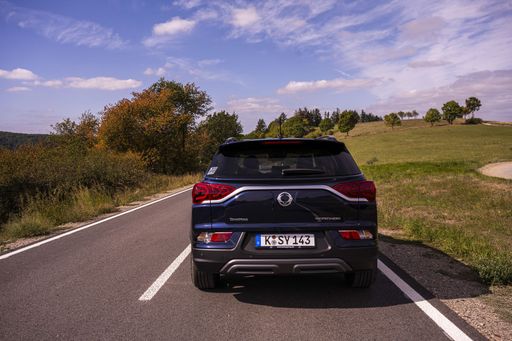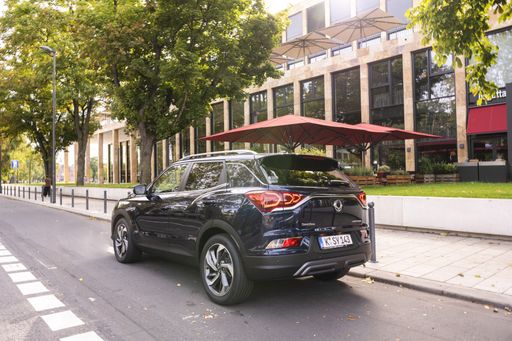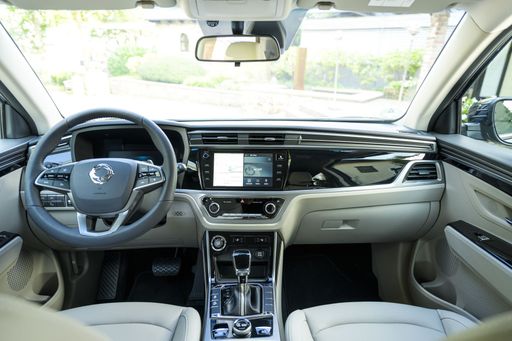SsangYong Korando vs Kia PV5 – Technische Daten, Verbrauch & Preise im Vergleich
Welches Modell überzeugt mehr – der SsangYong Korando oder der Kia PV5?
Wir vergleichen für dich Leistung (190 PS vs 121 PS), Kofferraumvolumen (551 L vs ), Verbrauch (16.80 kWh7.50 L vs ) und natürlich den Preis (32300 Fr. vs 36700 Fr.).
Finde jetzt heraus, welches Auto besser zu dir passt!
Der SsangYong Korando (SUV) wird mit einem Benzin oder Elektro-Motor angetrieben und ist mit einem Manuel oder Automatik Getriebe ausgestattet. Im Vergleich dazu hat der Kia PV5 (Transporter) einen Elektro-Motor und ein Automatik Getriebe.
In Sachen Kofferraumvolumen bietet dir der 551 L beim SsangYong Korando bzw. beim Kia PV5 ausreichend Platz – je nachdem, worauf du Wert legst. Wer mehr Leistung sucht, muss wählen ob die 190 PS des SsangYong Korando oder die 121 PS des Kia PV5 für die eigenen Bedürfnisse genügen.
Auch beim Verbrauch unterscheiden sich die beiden Modelle: 16.80 kWh7.50 L vs . Preislich liegt der SsangYong Korando bei 32300 Fr., während der Kia PV5 bei 36700 Fr. zu haben ist.
Vergleiche alle Daten direkt und finde heraus, welches Modell zu deinem Lifestyle passt!
SsangYong Korando
Der SsangYong Korando präsentiert sich mit einem robusten Design, das sowohl modernen als auch traditionellen Ansprüchen gerecht wird. Im Innenraum bietet er viel Komfort und Praktikabilität, um sowohl Fahrer als auch Passagiere zufrieden zu stellen. Dank seiner fortschrittlichen Sicherheits- und Technologiefeatures ist er bestens für den Alltag sowie längere Fahrten gerüstet.
Details @ Ssangyong
@ Ssangyong
 @ Ssangyong
@ Ssangyong
 @ Ssangyong
@ Ssangyong
 @ Ssangyong
@ Ssangyong
 @ Ssangyong
@ Ssangyong
Kia PV5
The Kia EV5 is an exciting new entrant in the landscape of electric SUVs, promising a blend of style and innovation that captures attention. It boasts a sleek and modern design that aligns with Kia's evolving aesthetic identity, blending practicality with eye-catching details. With its foray into the electric vehicle segment, the EV5 is set to offer a highly competitive option for those looking to embrace sustainable mobility without compromising on comfort or tech features.
Details

|
|
|
|
|
Kosten und Verbrauch |
|
|---|---|
|
Preis
32300 - 45900 Fr.
|
Preis
36700 Fr.
|
|
Verbrauch L/100km
7.5 - 8.6 L
|
Verbrauch L/100km
-
|
|
Verbrauch kWh/100km
16.80 kWh
|
Verbrauch kWh/100km
-
|
|
Elektrische Reichweite
339 km
|
Elektrische Reichweite
291 km
|
|
Batteriekapazität
-
|
Batteriekapazität
51.50 kWh
|
|
co2
0 - 197 g/km
|
co2
0 g/km
|
|
Tankgröße
50 L
|
Tankgröße
-
|
Maße und Karosserie |
|
|---|---|
|
Karosserie
SUV
|
Karosserie
Transporter
|
|
Sitze
5
|
Sitze
2
|
|
Türen
5
|
Türen
4
|
|
Leergewicht
1517 - 1840 kg
|
Leergewicht
-
|
|
Kofferraum
551 L
|
Kofferraum
-
|
|
Länge
4450 - 4465 mm
|
Länge
4695 mm
|
|
Breite
1870 mm
|
Breite
1850 mm
|
|
Höhe
1620 - 1645 mm
|
Höhe
1923 mm
|
|
Zuladung
410 - 463 kg
|
Zuladung
-
|
Motor und Leistung |
|
|---|---|
|
Motorart
Benzin, Elektro
|
Motorart
Elektro
|
|
Getriebe
Manuel, Automatik
|
Getriebe
Automatik
|
|
Getriebe Detail
Schaltgetriebe, Automatikgetriebe, Reduktionsgetriebe
|
Getriebe Detail
Reduktionsgetriebe
|
|
Antriebsart
Frontantrieb, Allrad
|
Antriebsart
Frontantrieb
|
|
Leistung PS
163 - 190 PS
|
Leistung PS
121 PS
|
|
Beschleunigung 0-100km/h
8.40 s
|
Beschleunigung 0-100km/h
16.30 s
|
|
max. Geschwindigkeit
156 - 191 km/h
|
max. Geschwindigkeit
135 km/h
|
|
Drehmoment
260 - 360 Nm
|
Drehmoment
250 Nm
|
|
Anzahl Zylinder
4
|
Anzahl Zylinder
-
|
|
Leistung kW
120 - 140 kW
|
Leistung kW
89 kW
|
|
Hubraum
1497 cm3
|
Hubraum
-
|
Allgemein |
|
|---|---|
|
Modelljahr
2021 - 2023
|
Modelljahr
2025
|
|
CO2-Effizienzklasse
F, G, A
|
CO2-Effizienzklasse
A
|
|
Marke
SsangYong
|
Marke
Kia
|
SsangYong Korando
Der SsangYong Korando: Ein SUV mit Charakter
Der SsangYong Korando hat sich seit seiner Einführung als robustes und vielseitiges SUV einen Namen gemacht. Mit einem gelungenen Mix aus Technik, Komfort und Innovation ist der Korando bereit, sowohl die Stadt als auch das Gelände zu erobern.
Technische Details, die überzeugen
Unter der Haube des SsangYong Korando arbeitet ein leistungsstarker 1.5 GDI-T Benzinmotor, der eine PS-Leistung von bis zu 163 bietet. Erhältlich in verschiedenen Antriebskonfigurationen, darunter Front- und Allradantrieb, bietet der Korando beeindruckende Flexibilität. Die Verbrauchswerte variieren zwischen 7.5 und 8.6 Litern pro 100 km, was für ein SUV dieser Klasse durchaus moderat ist. Für diejenigen, die einen umweltfreundlicheren Ansatz bevorzugen, bietet der Korando E-Motion eine elektrische Leistung von 190 PS und eine Reichweite von 339 km.
Innovative Technologien
Der SsangYong Korando ist nicht nur leistungsstark, sondern auch technisch fortschrittlich. Mit einem modernen Infotainment-System und intelligenten Assistenzsystemen wie Spurhalteassistent und adaptivem Tempomat sorgt er für ein sicheres und angenehmes Fahrerlebnis.
Komfort und Raumangebot
Mit einer Länge von bis zu 4465 mm und einer Breite von 1870 mm bietet der Korando ausreichend Platz für bis zu fünf Passagiere. Der Kofferraum fasst beeindruckende 551 Liter, ideal für Reisen jeglicher Art. Die Ausstattungslinien reichen von praktischen und funktionalen bis hin zu luxuriösen Versionen wie der "Titanium Plus 2WD", die höchsten Komfort bieten.
Wirtschaftlichkeit und CO2-Effizienz
Die Betriebskosten des SsangYong Korando bewegen sich zwischen 791 und 970 € pro Monat. Die CO2-Emissionen variieren je nach Modell und reichen von 0 (bei der Elektrovariante) bis 197 g/km, was ihn in die Effizienzklassen von A bis G einreiht.
Sicherheitsmerkmale
Bei der Sicherheit setzt SsangYong hohe Standards. Der Korando ist mit zahlreichen Features wie einem fortschrittlichen Airbag-System, ABS und ESP ausgestattet, die für einen umfassenden Schutz der Insassen sorgen.
Im Gesamten ist der SsangYong Korando ein SUV, das sowohl technisch als auch ökonomisch eine durchdachte Wahl darstellt. Egal ob in der Stadt oder im Gelände – der Korando bietet für jeden Fahrstil die passende Lösung.
Kia PV5
A Fresh Perspective on Cargo Vans: The Kia PV5
The Kia PV5 stands as a beacon of innovation in the realm of electric cargo vans. Known for its forward-thinking design and practicality, this model sets a new standard in its class. The PV5 combines cutting-edge technology with an eco-friendly design, redefining the expectations for businesses seeking sustainable transportation solutions.
Electric Power Meets Efficiency
At the heart of the Kia PV5 lies an advanced electric powertrain. The model is equipped with a 51.5 kWh battery, offering an impressive electric range of 291 km on a single charge. This robust power supply pairs with a front-wheel-drive system powered by an electric motor that delivers 121 HP (equivalent to 89 kW), keeping the operations both smooth and efficient.
Sustainability Without Compromise
The commitment to sustainability is evident in the PV5’s zero emissions, with a CO2 output of 0 g/km. The van maintains a CO2 Efficiency Class of A, clearly demonstrating Kia’s dedication to reducing the environmental impact of its vehicles. Businesses adopting the PV5 can confidently promote their green credentials while benefiting from the cost savings associated with electric driving.
Designed for Modern Business Needs
The Kia PV5 Cargo L2H1 Electric Automatic model is engineered for functionality and ease of use. Its spacious design accommodates two seats and offers a generous cargo area, making it perfect for diverse delivery needs. The van spans 4695 mm in length, 1850 mm in width, and 1923 mm in height, providing ample space to maneuver goods with ease.
Performance and Practicality
In terms of performance, the PV5 boasts a torque of 250 Nm and can accelerate from 0 to 100 km/h in 16.3 seconds. While its top speed is capped at 135 km/h, this is more than sufficient for urban and suburban delivery routes. The reduction gearbox ensures smooth transitions as it navigates through daily tasks.
Safety and Innovation
Safety is not compromised with the Kia PV5. It features a suite of safety technologies that support the driver in maintaining control and avoiding incidents. These innovations not only contribute to the safety of the driver and cargo but also offer peace of mind to businesses that prioritize the wellbeing of their workforce and goods.
The Road Ahead for Kia PV5
As the automotive industry continues to move towards electrification, the Kia PV5 exemplifies how cargo vans can adapt to this change seamlessly. It represents an essential step towards more sustainable business operations, providing a viable and efficient option for companies looking to reduce their carbon footprint while enhancing operational efficiency. The Kia PV5 is more than just a vehicle; it’s a strategic asset for any forward-thinking business.
Die angezeigten Preise und Daten sind Schätzungen, die auf deutschen Listenpreisen basieren, und können je nach Land variieren. Diese Informationen sind rechtlich nicht bindend.
